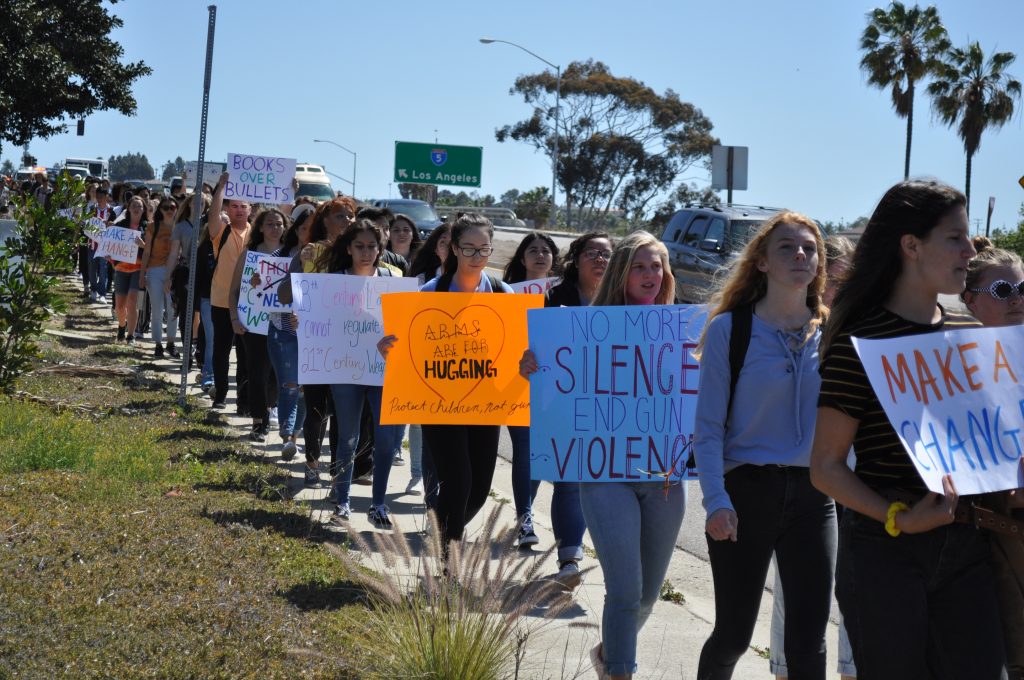Students at Clairemont High School in San Diego participate in a national school walkout in 2018 to demand gun control — almost two decades after Columbine.
David Washburn / EdSource
“Four dead in shooting at Georgia high school, 14-year-old suspect in custody.” The ABC News headline blasts across my Apple Watch.
I am in the middle of teaching ninth graders how to draw inferences to support an interpretation of Roald Dahl’s “Lamb to the Slaughter.” They’re captivated by housewife Mary Maloney’s stoic demeanor as she covers up her violent retaliation against her husband. I pause midstory to read the headline to myself, and without reacting, go back to modeling annotations as we uncover how Mary gets away with murder. The students are engaged, but I struggle to keep my own mind focused on the lesson, knowing classes are now canceled in another school, this time in Georgia.
Afterward, I sit at my desk surveying my classroom. I mentally map out safety spots, rehearsing scenarios for a lockdown. I wonder, “What will I do if we are at lunch? Or if there is a shooting between passing periods?” My thoughts teeter between precautionary mental plans and prayers of relief: t wasn’t us. I imagine many teachers, administrators and parents around the country are breathing that same sigh; thank goodness it wasn’t my classroom, my colleagues, my students, my child.
The cry for gun control and stricter safety measures seems to fade in the quiet period after a shooting, with little to no change after the national mourning. My anxiety as a teacher takes a hit every time we revisit this repetitive headline. It is personal and desperately frustrating to grapple with school shootings time and again. Amid the helplessness I feel in the aftermath, I start to think of ways to help my students and colleagues navigate through this repeated collective trauma. What can we do, within our community power, to process these tragedies?
Upon hearing that the shooter is 14 years old, my initial reaction is that school districts need to prioritize regular emotional check-ins for both students and staff. The research on the importance of social and emotional learning is clear: student perceptions of school safety and inclusion significantly improve with this support.
The age of the Georgia shooter underscores the urgency of this idea; an intentional emphasis on mental health in schools as a proactive measure can be instrumental in identifying those who may be struggling with psychological challenges. What violence markers were observed beforehand? How could this have been prevented? This is a challenging balance to navigate: ensuring that schools do not overstep in identifying potentially violent individuals while also teaching emotional intelligence as a preventive measure for students to handle stress. While fostering social and emotional learning within school curriculums cannot entirely eliminate the risk, mandating this is a proactive, researched step toward school safety.
School personnel also need proper professional development on how to handle trauma. When we see signs of stress, what do we do? We know students now, more than previous generations, buckle more frequently under emotional loads that impact their ability to learn, and teachers often feel ill-equipped to respond. We need structured systems of correspondence when we notice signs that someone — student or colleague — is struggling. Just as school safety plans are mandatory, there is a need for trauma-response systems and appropriate annual training.
One issue that has repeatedly surfaced in my classroom is the significant impact cyberbullying and social media have on today’s teenagers. How has technology hindered our efforts to keep students focused and, more importantly, to keep them safe? How has living in a virtual world affected students’ ability to navigate real-life interactions? While I recognize that school violence existed long before every teenager had a cellphone or access to social media, I can’t help but suspect a link between the rise in school-related violence and the fact that much of children’s social interaction now takes place in an impersonal, virtual environment.
As we respond emotionally to the shooting, the uncomfortably large elephant in the classroom is the urgent need for systemic change. Apalachee, Georgia, has been added to the list of communities grappling with the pain of government inaction. In the aftermath, schools across the nation are managing trauma response and reviewing their safety procedures, hoping to withstand a potential repeat event on their own campuses.
Wanting students and faculty to come home safely from school should not be a political issue; it is a basic expectation. The overwhelming responsibility for student safety falls on me and my colleagues to find creative ways to ensure our own safety. Instead, this pressure should fall squarely on our elected officials. While we wait for legislative action, we map our modes of escape, pay heed to the emotional toll these events have on our school communities, and pray fervently that we don’t ever experience our own versions of “Lamb to the Slaughter.” The shooting in Georgia is a reminder to check our own locks and security measures in case we become the unlucky next.
•••
Emily Garrison is an English teacher in Northwest Arkansas. She is a Teach Plus Senior Writing Fellow.
The opinions in this commentary are those of the author. We welcome guest commentaries with diverse points of view. If you would like to submit a commentary, please review our guidelines and contact us.

